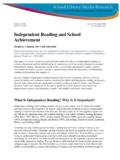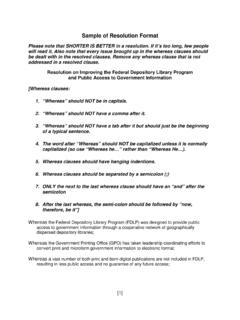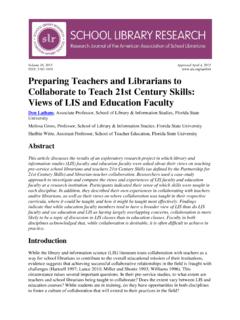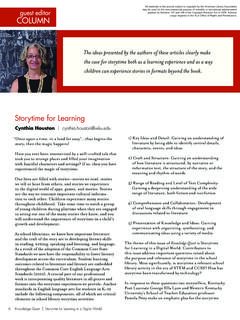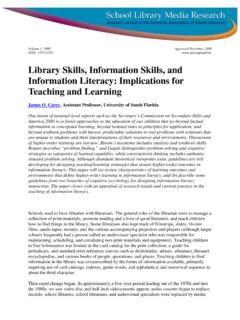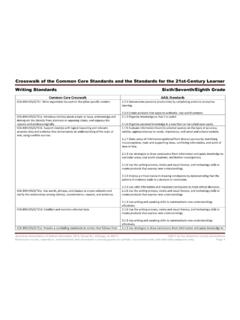Transcription of The Enchanted Imagination: Storytelling’s Power to ...
1 Volume 2, 1999 Approved July 1999. ISSN: 1523-4320 The Enchanted Imagination: Storytelling's Power to Entrance Listeners Brian W. Sturm, Assistant Professor, University of North Carolina at Chapel Hill Consciousness has been described as both a variety of discrete states and a constantly changing flow. Charles T. Tart has developed a systems approach to consciousness in which he describes a baseline state of normal, waking consciousness and multiple altered states induced by a disruption of that baseline. This concept of a system of interrelated components is applicable to the altered state of consciousness associated with listening to a story: the storylistening trance. This research was designed to be exploratory and to elicit information concerning the characteristics of the storylistening trance and any influences (positive or negative) that affect it.
2 The methodology was naturalistic, combining interviews and participant observation. The results show that many listeners do experience a qualitatively different state while listening to some stories. The article addresses characteristics of this trance state and influences upon it, and it concludes with a theoretical model of the storylistening trance and the applicability of the findings to library media specialists. from The Legend of the Destruction of Kash . Far-li-mas, today the day has arrived when you must cheer me. Tell me a story. The performance is quicker than the command, said Far-li-mas, and began. The king and his guests forgot to drink, forgot to breathe. The slaves forgot to serve. They, too, forgot to breathe.
3 For the art of Far-li-mas was like hashish, and, when he had ended, all were as though enveloped in a delightful swoon. The king had forgotten his thoughts of death. Nor had any realized that they were being held from twilight until dawn; but when the guests departed they found the sun in the sky. (Campbell 1969, 153 54) from What Happens When You Really Listen . On that day, the reciter was enchanting the audience with the story of Hanuman the monkey and how he had to leap across the ocean to take Rama's signet ring to Sita, the abducted wife of Rama. When Hanuman was making his leap, the signet ring slipped from his hand and fell into the ocean. Hanuman didn't know what to do. He had to get the ring back quickly and take it to Sita in the demon's kingdom.
4 While he was wringing his hands, the husband, who was listening with rapt attention in the first row, said, Hanuman, don't worry. I'll get it for you. Then he jumped up and dived into the ocean, found the ring in the ocean floor, and brought it back and gave it to Hanuman. (Ramanujan 1991, 56). Volume 2 | ISSN: 1523-4320. Statement of the Problem Storytelling has enjoyed a renaissance in the past twenty years. Books on how to select, prepare, and present stories fill bookstore shelves, and professional storytellers make careers of performing stories at festivals, libraries, schools, and conferences throughout the nation. The leading national journal of storytelling, Storytelling Magazine, is filled with opinion pieces, but while storytelling has flourished, there has not been a concomitant surge in research of the art form.
5 One element of storytelling has remained nearly unconsidered, and it is, perhaps, the most profound and influential characteristic of storytelling: its Power to entrance those who listen. As the excerpts from the stories above show, people who listen to stories can undergo a profound change in their experience of reality. The normal, waking state of consciousness changes as the story takes on a new dimension; listeners seem to experience the story with remarkable immediacy, engaging in the story's plot and with the story's characters, and they may enter an altered state of consciousness: a storylistening trance. What is this phenomenon, and what does the listener experience during this altered state? Is it qualitatively different from one's normal state of consciousness and in what ways?
6 What influences one's ability to experience this altered state? Of what import is this altered state to library media specialists? These are the questions that this article addresses as I build a phenomenologically rich description of the listener's experience of the entrancing Power of storytelling. Conceptual Framework The conceptual framework for this study is influenced by the theoretical principles of multiple disciplines, including psychology, cognitive science, literary philosophy, communication, folklore, rhetorical studies, linguistics, medicine, counseling, hypnosis, and religious studies. The principal elements, however, can be traced to the theories of reader's response criticism, consciousness and its states, and systems theory.
7 Louise Rosenblatt (1978, 12), a prominent reader's response theoretician, discusses the need in literary philosophy and literary criticism to study the impact of a text on its reader. She draws a useful distinction between a text and a poem, claiming that the text is that which the author creates, while the true poem is that which the reader creates, using the text as the foundation and adding to it personal associations, experiences, images, memories, expectations, perceptions, and the like. The poem [is] the experience shaped by the reader under the guidance of the text. This concept is applicable to the storytelling event. The storyteller recounts the text, while the listeners create the true story based on the verbal text and overlaid with personal images and memories.
8 While there is a continual feedback loop present in any storytelling event as the teller changes the story to accommodate the audience the unit of study, following Rosenblatt's thesis, is not the storyteller's performance but the listener's experience. Research of consciousness has taken diverse perspectives. Structuralists have concentrated on describing the elements of consciousness, the discrete units that may compose it (Battista 1978;. Marsh 1977; Csikszentmihalyi 1990). Functionalists have emphasized the significance of psychological processes to the ongoing development of the individual and his or her role in society (Stephen 1979), while behaviorists claim either that consciousness should not be the focus of psychological inquiry at all since it is not an external, perceptible behavior (Watson 1913), or that it should be linked to physiological events (Boring 1963).
9 Finally, the 2 School Library Media Research | Volume 2 | ISSN: 1523-4320. constructivist notion that organisms construct the universe in which they live based on cultural, environmental, and personal perceptions has reinvigorated the study of consciousness. The current study rests squarely within the framework of this latest concept of consciousness, although there is evidence of each of these trends. If people construct their realities, then to understand their experience of the world, one must explore with them their perceptions, expectations, and personal constructs. Interviews, the principal methodological approach for this study, must focus on obtaining precisely this information. I emulate the structuralists when I.
10 Define some of the elements that comprise the storylistening trance experience, group them into categories, and explore the system behind the flow of this experience. The methodology also draws from the behaviorists' idea of perceptible behavior as I engaged in participant observation, though I do not ascribe to their indifference toward consciousness itself. The functionalists'. approach is perhaps the least represented in this study, for I made no determined effort to discover the utility of this altered state of consciousness. Systems theory, and holistic thinking in general, has become popular in the last thirty years, and it is being productively applied to many areas of research. It arose as a reaction to the mechanistic paradigm (the dominant paradigm based in seventeenth-century physics) that views nature as inert, truth as value-free, cause and effect as basically linear, and consciousness as epiphenomenal, a mere reflection of neural processes in the brain (Berman 1996).
